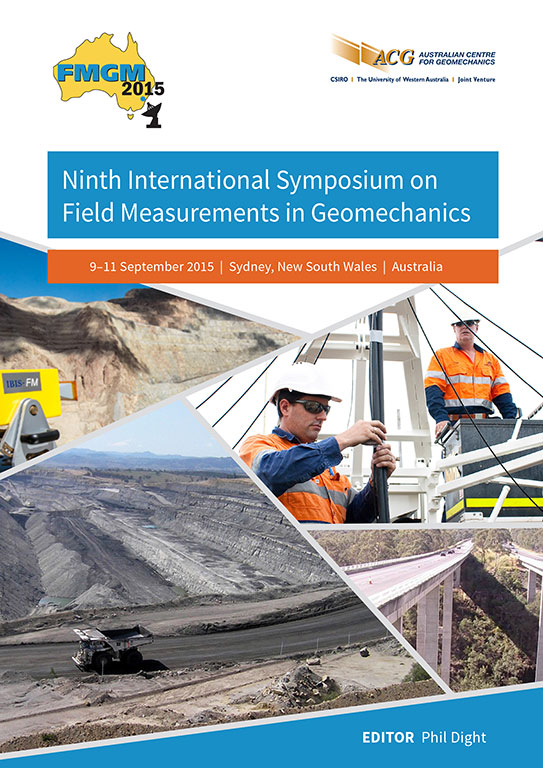Quarrying-induced subsidence investigated by combining contact and remote monitoring systems

|
Authors: Bozzano, F; Esposito, C; Mazzanti, P; Rocca, A Paper is not available for download Contact Us |
DOI https://doi.org/10.36487/ACG_rep/1508_31_Bozzano
Cite As:
Bozzano, F, Esposito, C, Mazzanti, P & Rocca, A 2015, 'Quarrying-induced subsidence investigated by combining contact and remote monitoring systems', in PM Dight (ed.), FMGM 2015: Proceedings of the Ninth Symposium on Field Measurements in Geomechanics, Australian Centre for Geomechanics, Perth, pp. 465-474, https://doi.org/10.36487/ACG_rep/1508_31_Bozzano
Abstract:
This work focuses on a multidisciplinary study carried out in an urban area located 20 km east of Rome, Italy affected by subsidence (and related structural damages) induced by dewatering related to quarrying activities. An intense monitoring activity has been carried out in order to understand the spatial and temporal evolution of the process by using both contact and remote sensing methodologies. Underground geological setting has been derived thanks to geotechnical investigations carried out by means of more than 90 boreholes. The hydrogeological variations occurred in the last decades as the response to the anthropic stress, has been obtained by a 3D numerical model based on a large piezometric monitoring dataset. Single buildings have been monitored by means of levelling and total stations, while on site instruments to monitor the groundwater levels (electric cluster piezometers) and in depth ground deformation (assestimeter) have been installed. On larger scale, multi-temporal aerial photos have been analysed to infer the increase of quarrying exploitation, whereas satellite A-DInSAR analyses have been carried out at different scales in order to achieve information about past displacements. This comprehensive set of data allowed us to describe the space and time distribution of the subsidence process.
References:
Berardino, P, Fornaro, G, Lanari, R & Sansosti, E 2002, ‘A new algorithm for surface deformation monitoring based on small baseline differential SAR interferograms’, IEEE Transactions on Geoscience and Remote Sensing, vol. 40, no. 11, pp. 2375-2383.
Billi, A, Valle, A, Brilli, M, Faccenna, C & Funiciello, R 2007, ‘Fracture-controlled fluid circulation and dissolutional weathering in sinkhole-prone carbonate rocks from central Italy’, Journal of Structural Geology, vol. 29, no. 3, pp. 385-395.
Boni, C, Bono, P & Capelli, G 1986, ‘Schema idrogeologico dell’Italia Centrale [Hydrogeological scheme of Central Italy]’,
Memorie - Società Geologica Italiana, vol. 35, pp. 991-1012.
Brunetti, E, Jones, JP & Petitta, M 2013, ‘Assessing the impact of large-scale dewatering on fault-controlled aquifer systems: a case study in the Acque Albule basin (Tivoli, central Italy)’, Hydrogeology Journal, vol. 21, pp. 401-423.
Capelli, G, Cosentino, D, Messina, P, Raffi, R & Ventura, G 1987, ‘Modalità di ricarica e assetto strutturale dell’acquifero delle sorgenti Capore - S. Angelo (Monti Lucretili - Sabina Meridionale)’, Geologica Romana, vol. 26, pp. 419-447.
Capelli, G, Mazza, R & Taviani, S 2005, ‘Studi idrogeologici per la definizione degli strumenti operativi del piano stralcio per l’uso compatibile delle risorse idriche sotterranee nell’ambito dei sistemi acquiferi prospicienti i territori vulcanici laziali’. Relazione inedita, Università degli Studi di Roma III, Dipartimento di Scienze Geologiche, laboratorio di Idrogeologia
(in Italian).
Curlander, JC & Mcdonough, RN 1991, Synthetic aperture radar: systems and signal processing, John Wiley & Sons, New York, USA.
Faccenna, C 1994, ‘Structural and hydrogeological features of Pleistocene shear zones in the area of Rome (central Italy)’, Annali di Geofisica, vol. 37, no. 1, pp. 121‐133.
Faccenna, C, Funiciello, R & Mattei, M 1994, ‘Late Pleistocene N-S shear zones along the Latium Tyrrhenian margin: structural characters and volcanological implications’, Bollettino di Geofisica Teorica ed Applicada, vol. 36, pp. 507-522.
Faccenna, C, Soligo, M, Billi, A, De Filippis, L, Funiciello, R, Rossetti, C & Tuccimei, P 2008, ‘Late Pleistocene cycles of travertine deposition and erosion, Tivoli, Central Italy: possible influence of climate changes and fault-related deformation’, Global Planetary Change, vol. 63, no. 4, pp. 299-308.
Ferretti, A, Prati, C & Rocca, F 2000, ‘Non-linear subsidence rate estimation using permanent scatterers in differential SAR interferometry’, IEEE Transactions on Geoscience and Remote Sensing, vol. 38, no. 5, pp. 2202-2212.
Ferretti, A, Prati, C & Rocca, F 2001, ‘Permanent scatterers in SAR interferometry’ IEEE Transactions on Geoscience and Remote Sensing, vol. 39, no. 1, pp. 8-20.
Floris, M, Bozzano, F, Strappaveccia, C, Baiocchi, V & Prestininzi, A 2014, ‘Qualitative and quantitative evaluation of the influence of anthropic pressure on subsidence in a sedimentary basin near Rome’, Environmental Earth Sciences, vol. 72, no. 11, pp. 4223-4236.
Hanssen, RF 2001, Radar interferometry: data interpretation and error analysis, Springer Netherlands, Netherlands, 308 p.
Hooper, A, Zebker, H, Segall, P & Kampes, B 2004, ‘A new method for measuring deformation on volcanoes and other natural terrains using InSAR persistent scatterers’, Geophysical Research Letters, vol. 312, no. 23.
Kampes, BM 2006, Radar interferometry: persistent scatterer technique, Springer Netherlands, Netherlands, 211 p.
Perissin, D & Wang, T 2012, ‘Repeat-pass SAR interferometry with partially coherent targets’, IEEE Transactions on Geoscience and Remote Sensing, vol. 50, no. 1, pp. 271-280.
Perissin, D, Wang, Z & Wang, T 2011, ‘The SARPROZ InSAR tool for urban subsidence/manmade structure stability monitoring in China’, Proceedings of the 34th International Symposium on Remote Sensing of Environment (ISRSE 2010).
© Copyright 2025, Australian Centre for Geomechanics (ACG), The University of Western Australia. All rights reserved.
View copyright/legal information
Please direct any queries or error reports to repository-acg@uwa.edu.au
View copyright/legal information
Please direct any queries or error reports to repository-acg@uwa.edu.au